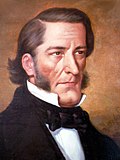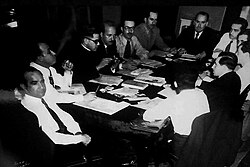
Presidents of the Republic of Costa Rica [1] [4] | Province | Term
(Election) | Profession | Faction/Party | Vice President |
|---|
|
| 1 |  | José María Castro Madriz | San José | August 31, 1848 – November 15, 1849
(1847, deposed) | Lawyer | Liberal | Manuel José Carazo Bonilla (1848–1849)
Juan Rafael Mora Porras (1849) |
| 1.a |  | Miguel Mora Porras | San José | November 16–26, 1849
(interim) | Trader | Liberal | Vacant |
| 2 |  | Juan Rafael Mora Porras | San José | November 26 – December 30, 1849 – August 14, 1859
(1849, 1853 and 1859. Deposed by Montealegre.) | Empresario | Liberal | Francisco María Oreamuno Bonilla† (1853–1856)
Vicente Aguilar Cubero (1856–1857)
Rafael García-Escalante Nava (1857–1859) |
| 3 |  | José María Montealegre Fernández | San José | 14 August 1859 – 8 May 1863
(de facto after a coup, later elected in 1860) | Medic | Liberal | Abolished
Alternates appointed by Congress. |
| 4 |  | Jesús Jiménez Zamora | Cartago | 8 May 1863 – 8 May 1866
(1863) | Medic | Liberal |
| 5 |  | José María Castro Madriz | San José | May 8, 1866 – November 1, 1868
(1866, deposed by Jiménez.) | Lawyer | Liberal |
| 6 |  | Jesús Jiménez Zamora | Cartago | November 1, 1868 – April 27, 1870
(de facto after a coup, elected as single candidate in 1869, deposed by coup led by Guardia.) | Medic | Liberal |
| 7 |  | Bruno Carranza Ramírez | San José | April 27 – August 8, 1870
(interim, appointed by Guardia.) | Medic | Liberal |
| 8 |  | Tomás Guardia Gutiérrez | Guanacaste | August 8, 1870 – May 8, 1876
(de facto after coup, elected in 1872).) | Military | Liberal |
| 9 |  | Aniceto Esquivel Sáenz | Cartago | May 8, 1876 – July 30, 1876
(1876 as Guardia's puppet, deposed by Guardia). | Lawyer | Liberal |
| 10 |  | Vicente Herrera Zeledón | San José | 30 July 1876 – 23 September 1877
(Appointed by Guardia, resigns due to health issues.) | Lawyer | Conservative |
| 11 |  | Tomás Guardia Gutiérrez† | Guanacaste | September 23, 1877 – July 6, 1882
(ruled as a dictator, died in office.) | Military | Liberal |
| 12 |  | Saturnino Lizano Gutiérrez | Puntarenas | July 6 – August 10, 1882
(interim) | Trader | Liberal |
| 13 |  | Próspero Fernández Oreamuno† | San José | August 10, 1882 – March 12, 1885
(1882. Died in office) | Philosopher | Olympus |
| 14 |  | Bernardo Soto Alfaro | Alajuela | March 12, 1885 – November 7, 1889
(interim later elected in 1886, resigns.) | Military and lawyer | Olympus |
| 14.a |  | Carlos Durán Cartín | San José | November 7, 1889 – May 8, 1890
(interim) | Medic | Liberal |
| 15 |  | José Rodríguez Zeledón | San José | 8 May 1890 – 8 May 1894
(1889) | Lawyer | Constitutional Party |
| 16 |  | Rafael Yglesias Castro | San José | 8 May 1894 – 8 May 1902
(1894 and 1897–1898) | Businessman | Civil Party |
| 17 |  | Ascensión Esquivel Ibarra | Guanacaste | 8 May 1902 – 8 May 1906
(1901–1902) | Lawyer | National Union Party |
| 18 |  | Cleto González Víquez | Heredia | 8 May 1906 – 8 May 1910
(1905–1906) | Lawyer | National Party |
| 19 |  | Ricardo Jiménez Oreamuno | Cartago | 8 May 1910 – 8 May 1914
(1909–1910) | Lawyer | Republican Party |
| 20 |  | Alfredo González Flores | Heredia | May 8, 1914 – January 27, 1917
(Appointed by Congress, deposed in the 1917 Costa Rican coup d'état led by Tinoco). | Lawyer | Republican Party |
| 21 |  | Federico Alberto Tinoco Granados | San José | January 27, 1917 – August 20, 1919
(ruled after coup, elected as single candidate in 1917, deposed by popular uprising). | Businessman | Peliquista Party |
| 22 |  | Juan Bautista Quirós Segura | San José | August 20, 1919 – September 2, 1919
(interim, forced to resign). | Empresario | Peliquista Party |
| 23 |  | Francisco Aguilar Barquero | Cartago | 2 September 1919-8 May 1920
(interim). | Teacher | Republican Party |
| 24 |  | Julio Acosta García | Alajuela | 8 May 1920-8 May 1924
(1919) | Diplomatic | Constitutional Party |
| 25 |  | Ricardo Jiménez Oreamuno | Cartago | May 8, 1924 – May 8, 1928
(1923) | Lawyer | Republican Party |
| 26 |  | Cleto González Víquez | Heredia | 8 May 1928-8 May 1932
(1928) | Lawyer | National Union Party |
| 27 |  | Ricardo Jiménez Oreamuno | Cartago | May 8, 1932 – May 8, 1936
(1932) | Lawyer | National Republican Party |
| 28 |  | León Cortés Castro | Alajuela | 8 May 1936-8 May 1940
(1936) | Teacher and lawyer | National Republican Party |
| 29 |  | Rafael Ángel Calderón Guardia | San José | 8 May 1940-8 May 1944
(1940) | Medic | National Republican Party |
| 30 |  | Teodoro Picado Michalski | San José | May 8, 1944 – April 19, 1948
(1944, deposed by civil war). | Teacher | National Republican Party |
| 30.a |  | Santos León Herrera | San José | April 19 – May 8, 1948
(interim). | Engineer | National Republican Party |











































































